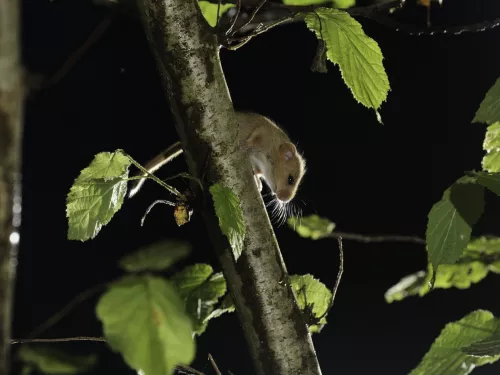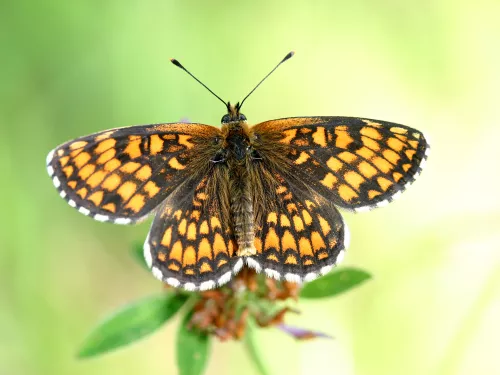
Harvest mouse
The harvest mouse is tiny - an adult can weigh as little as a 2p piece! It prefers habitats with long grass, but you are most likely to spot its round, woven-grass nests.

The harvest mouse is tiny - an adult can weigh as little as a 2p piece! It prefers habitats with long grass, but you are most likely to spot its round, woven-grass nests.
The hawfinch is the UK's largest finch, with an enormous bill powerful enough to crush a cherry stone. Despite their size, they are typically elusive, especially during the summer nesting season.
Our largest shieldbug, the red-and-green hawthorn shieldbug can be seen in gardens, parks and woodlands, feeding on hawthorn, rowan and whitebeam. The adults hibernate over winter.
Hazel is a small tree of woodlands, grasslands and gardens that is regularly coppiced - the practice of cutting the stems of a tree to allow new shoots to grow. It is well known for its long, yellow catkins.

Hazel dormice are hard to spot – not only do they only come out at night, but they are also only found in very few places in the UK. Dormice spend a lot of their time hibernating – and are known to snore!
The Heath bumblebee is not only found on heathland, but also in gardens and parks. It nests in small colonies of less than 100 workers in all kinds of spots, such as old birds' nests, mossy beds and even roofs!

The rare heath fritillary was on the brink of extinction in the 1970s, but conservation action turned its fortunes around. It is still confined to a small number of sites in the south of England, however.
Heather is also called 'ling'. Look for it on our heaths, moors and bogs, where its delicate, loosely arranged pink flowers attract all kinds of nectar-loving insects.
A climbing plant of woodlands, hedgerows, riverbanks and gardens, Hedge bindweed can become a pest in some places. It has large, trumpet-shaped, white flowers and arrow-shaped leaves.
Hedge mustard is a tall plant with small, yellow flowers atop tough stems. It likes disturbed ground and grows in hedgerows and roadside verges, and on waste ground.
The unpleasant, astringent smell of Hedge woundwort makes this medium-sized plant of woodlands, hedgerows and roadside verges stand out from the crowd.
A common hoverfly, the Heineken fly has a distinctively long snout that enables it to take nectar from deeper flowers, reaching the parts other hoverflies cannot reach! It frequents hedgerows, gardens and woods.